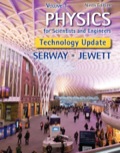
Concept explainers
A zoom lens system is a combination of lenses that produces a variable magnification of a fixed object as it maintains a fixed image position. The magnification is varied by moving one or more lenses along the axis. Multiple lenses are used in practice, but the effect of zooming in on an object can be demonstrated with a simple two-lens system. An object, two converging lenses, and a screen are mounted on an optical bench. Lens 1, which is to the right of the object, has a focal length of f1 = 5.00 cm, and lens 2, which is to the right of the first lens, has a focal length of f2 = 10.0 cm. The screen is to the right of lens 2. Initially, an object is situated at a distance of 7.50 cm to the left of lens 1, and the image formed on the screen has a magnification of +1.00. (a) Find the distance between the object and the screen. (b) Both lenses are now moved along their common axis while the object and the screen maintain fixed positions until the image formed on the screen has a magnification of +3.00. Find the displacement of each lens from its initial position in part (a). (c) Can the lenses be displaced in more than one way?
(a)
Answer to Problem 36.94CP
Explanation of Solution
Given info: The focal length of the left and right lenses are
Write the expression of thin lens equation for lens 1.
Here,
Substitute
Write the expression for magnification.
Substitute
Write the expression of magnification for a combination of two lenses.
Substitute
Write the expression to calculate the magnification for lens 2.
Substitute
Write the expression of thin lens equation for lens 2.
Here,
Substitute
Substitute
The distance between the object and the screen is,
Substitute
Thus, the distance between the object and the screen is
Conclusion:
Therefore, the distance between the object and the screen is
(b)
Answer to Problem 36.94CP
Explanation of Solution
Given info: The focal length of the left and right lenses are
Write the expression of thin lens equation for lens 1.
Here,
Substitute
Write the expression of magnification for lens 1.
Substitute
Write the expression of magnification for the combination of lenses.
Substitute
Write the expression to calculate the magnification of lens 2.
Substitute
Write the expression of lens equation for lens 2.
Substitute
Substitute
The distance between the object and the screen is,
Substitute
Solve the above quadratic equation to find the value of
When the value of
The displacement of object is,
Substitute
The displacement of the image is,
When the value of
The displacement of object is,
Substitute
The displacement of the image is,
Thus, the displacement of each lens from its initial position is
Conclusion:
Therefore, the displacement of each lens from its initial position is
(c)
Answer to Problem 36.94CP
Explanation of Solution
Given info: The focal length of the left and right lenses are
Yes the lens can be displaced in more than one way.
The first lens can be displaced
Another way is, the first lens can be moved
Thus, it is possible to displace the lens in more than one way.
Conclusion:
Therefore, it is possible to displace the lens in more than one way.
Want to see more full solutions like this?
Chapter 36 Solutions
EBK PHYSICS FOR SCIENTISTS AND ENGINEER
- What fuel economy should be expected from a gasoline powered car that encounters a total of 443N of resistive forces while driving down the road? (Those forces are from air drag, rolling resistance and bearing losses.) Assume a 30% thermodynamic efficiency.arrow_forwardNo chatgpt pls will upvotearrow_forward12. What is the angle between two unit vectors if their dot product is 0.5?arrow_forward
- If the car in the previous problem increases its power output by 10% (by pressing the gas pedal farther down), at what rate will the car accelerate? Hint: Consider the net force. In the previous problem the power was 31.8kWarrow_forwardWhat power is required (at the wheels) for a 1400 kg automobile to climb a 4% grade at a constant speed 30 m/s while it is opposed by drag and rolling resistance forces totaling 500 N?arrow_forwardNo chatgpt pls will upvotearrow_forward
- As a box is lifted against gravity and placed on a shelf, how does the work done by the lifter compare with the work done by gravity? What is the net work done on the box? What does this imply about its change in kinetic energy? Use definitions and mathematics from this chapter to answer these questions.arrow_forwardAs I carry a box up a flight of stairs, am I doing positive work or negative work on the box? Provide a mathematical explanation.arrow_forwardAs a ball falls under the influence of gravity, does gravity do positive work or negative work? Provide a mathematical explanation.arrow_forward
 Principles of Physics: A Calculus-Based TextPhysicsISBN:9781133104261Author:Raymond A. Serway, John W. JewettPublisher:Cengage Learning
Principles of Physics: A Calculus-Based TextPhysicsISBN:9781133104261Author:Raymond A. Serway, John W. JewettPublisher:Cengage Learning Physics for Scientists and EngineersPhysicsISBN:9781337553278Author:Raymond A. Serway, John W. JewettPublisher:Cengage Learning
Physics for Scientists and EngineersPhysicsISBN:9781337553278Author:Raymond A. Serway, John W. JewettPublisher:Cengage Learning Physics for Scientists and Engineers with Modern ...PhysicsISBN:9781337553292Author:Raymond A. Serway, John W. JewettPublisher:Cengage Learning
Physics for Scientists and Engineers with Modern ...PhysicsISBN:9781337553292Author:Raymond A. Serway, John W. JewettPublisher:Cengage Learning Physics for Scientists and Engineers: Foundations...PhysicsISBN:9781133939146Author:Katz, Debora M.Publisher:Cengage Learning
Physics for Scientists and Engineers: Foundations...PhysicsISBN:9781133939146Author:Katz, Debora M.Publisher:Cengage Learning Physics for Scientists and Engineers, Technology ...PhysicsISBN:9781305116399Author:Raymond A. Serway, John W. JewettPublisher:Cengage Learning
Physics for Scientists and Engineers, Technology ...PhysicsISBN:9781305116399Author:Raymond A. Serway, John W. JewettPublisher:Cengage Learning Glencoe Physics: Principles and Problems, Student...PhysicsISBN:9780078807213Author:Paul W. ZitzewitzPublisher:Glencoe/McGraw-Hill
Glencoe Physics: Principles and Problems, Student...PhysicsISBN:9780078807213Author:Paul W. ZitzewitzPublisher:Glencoe/McGraw-Hill





